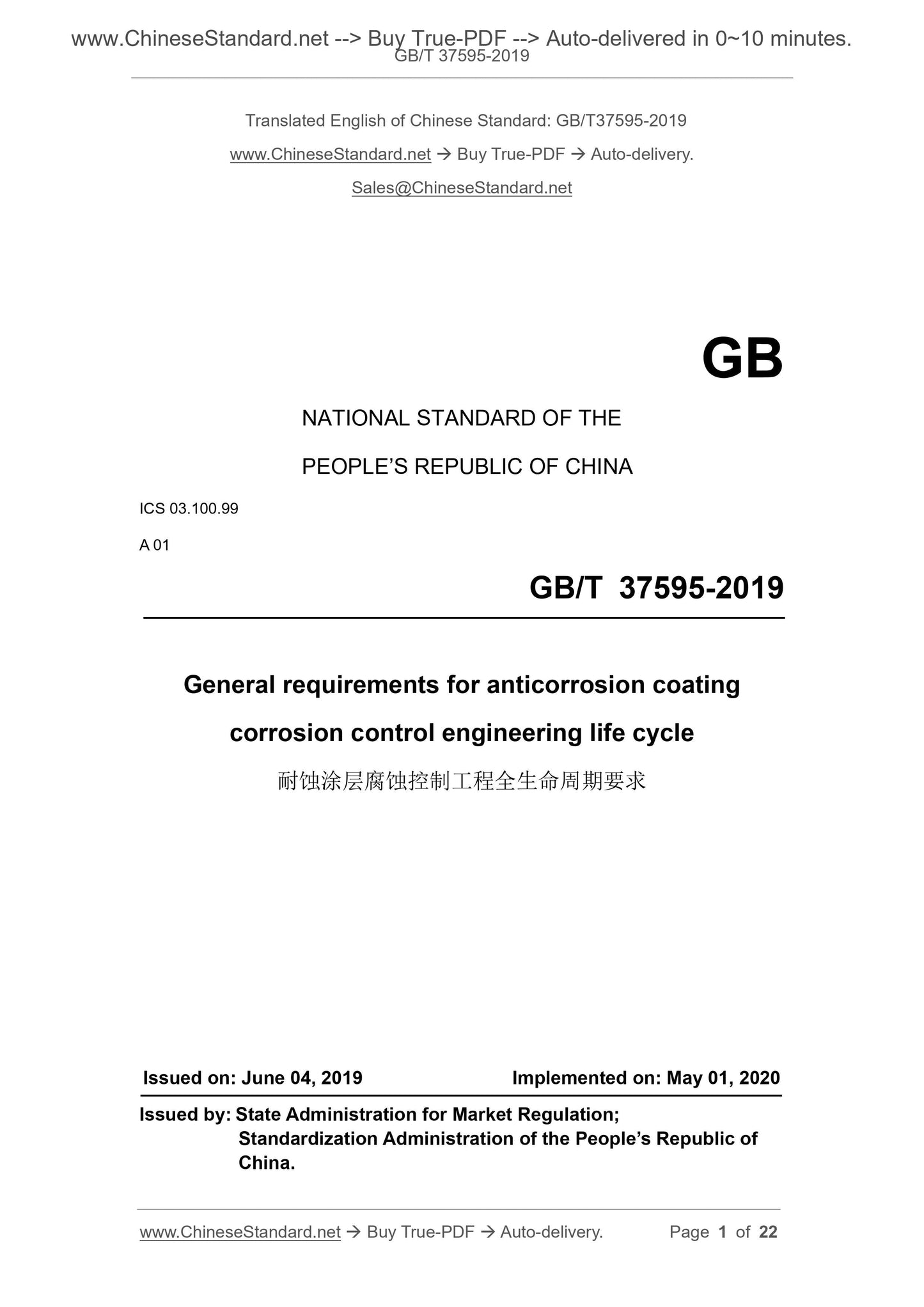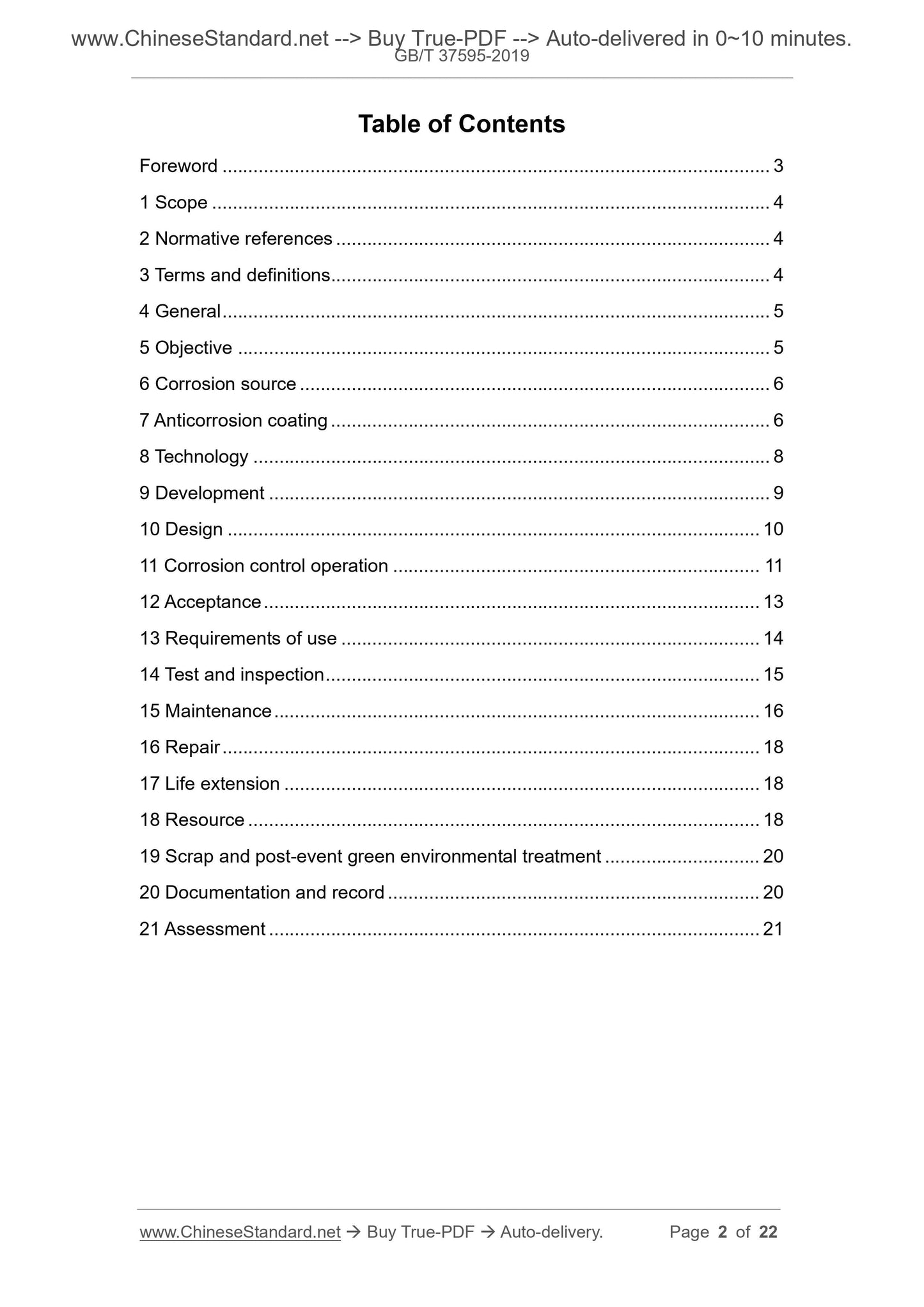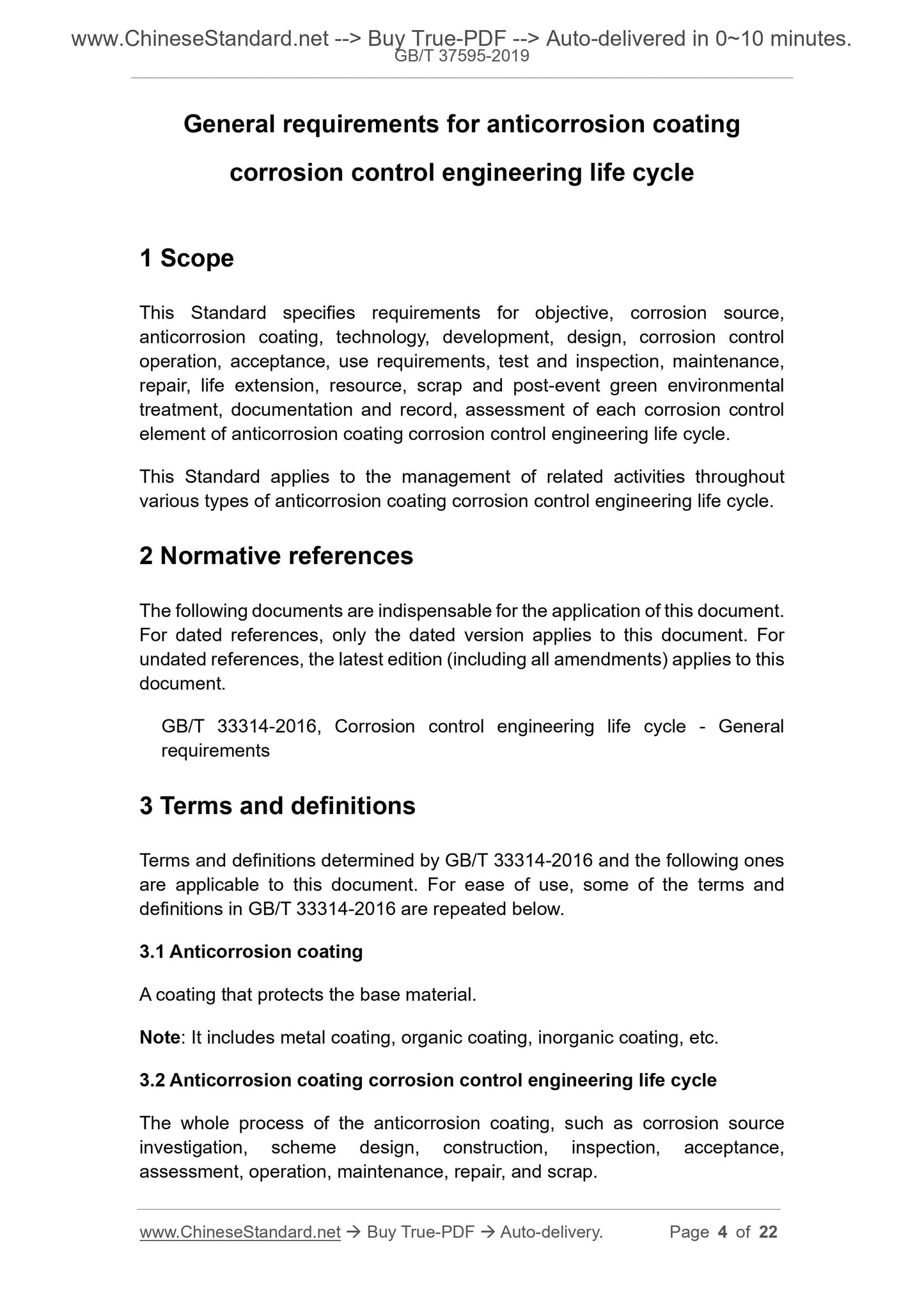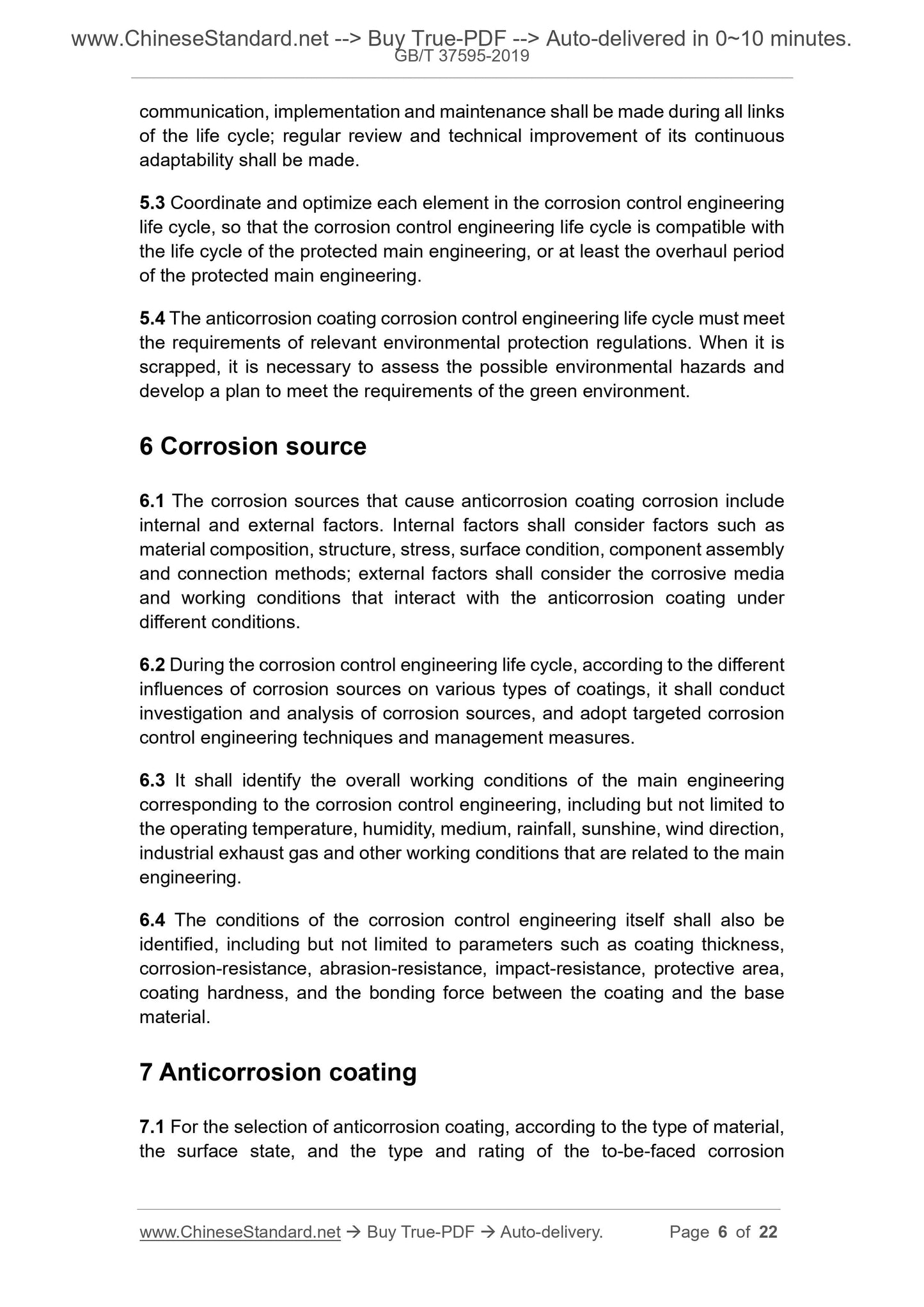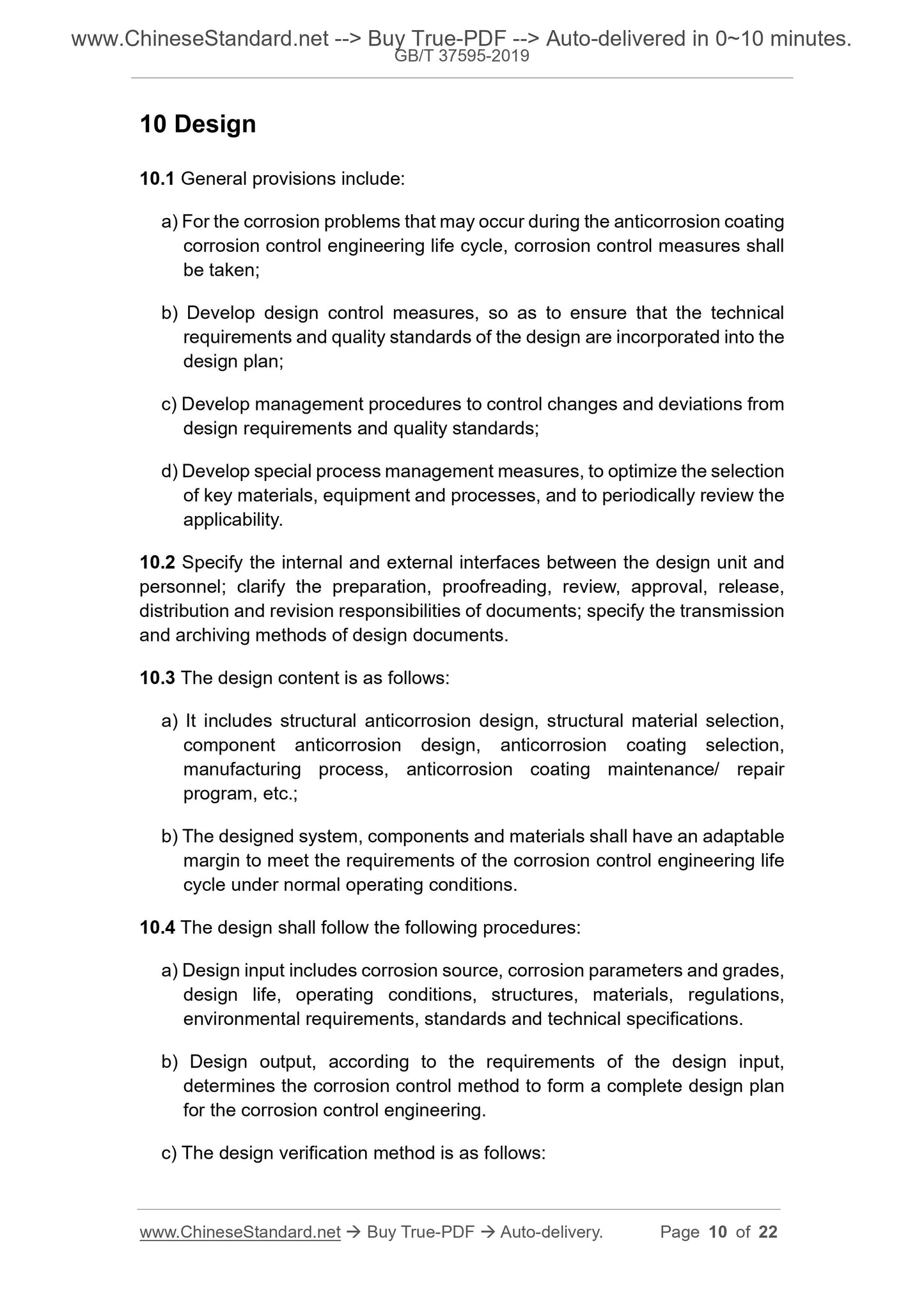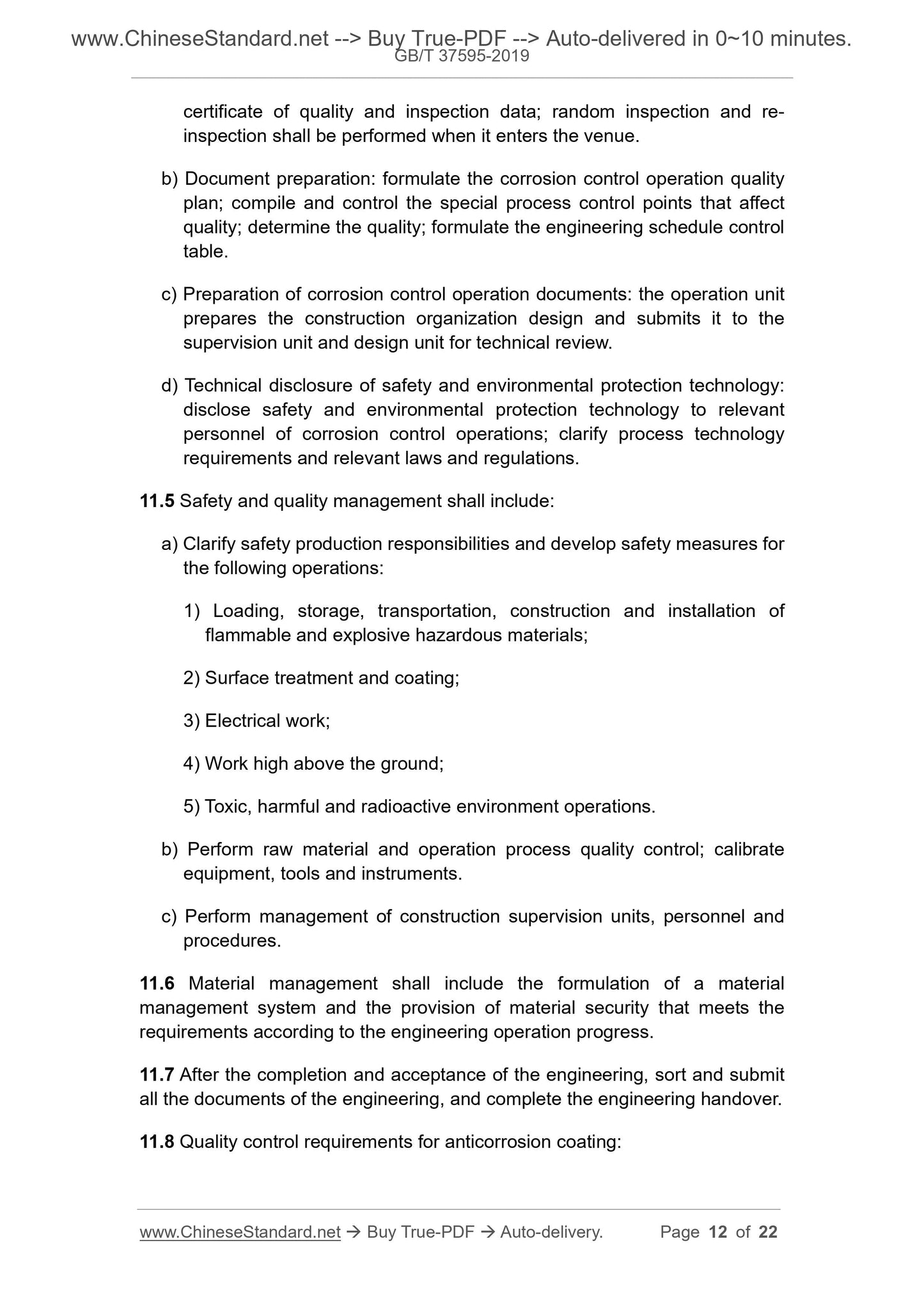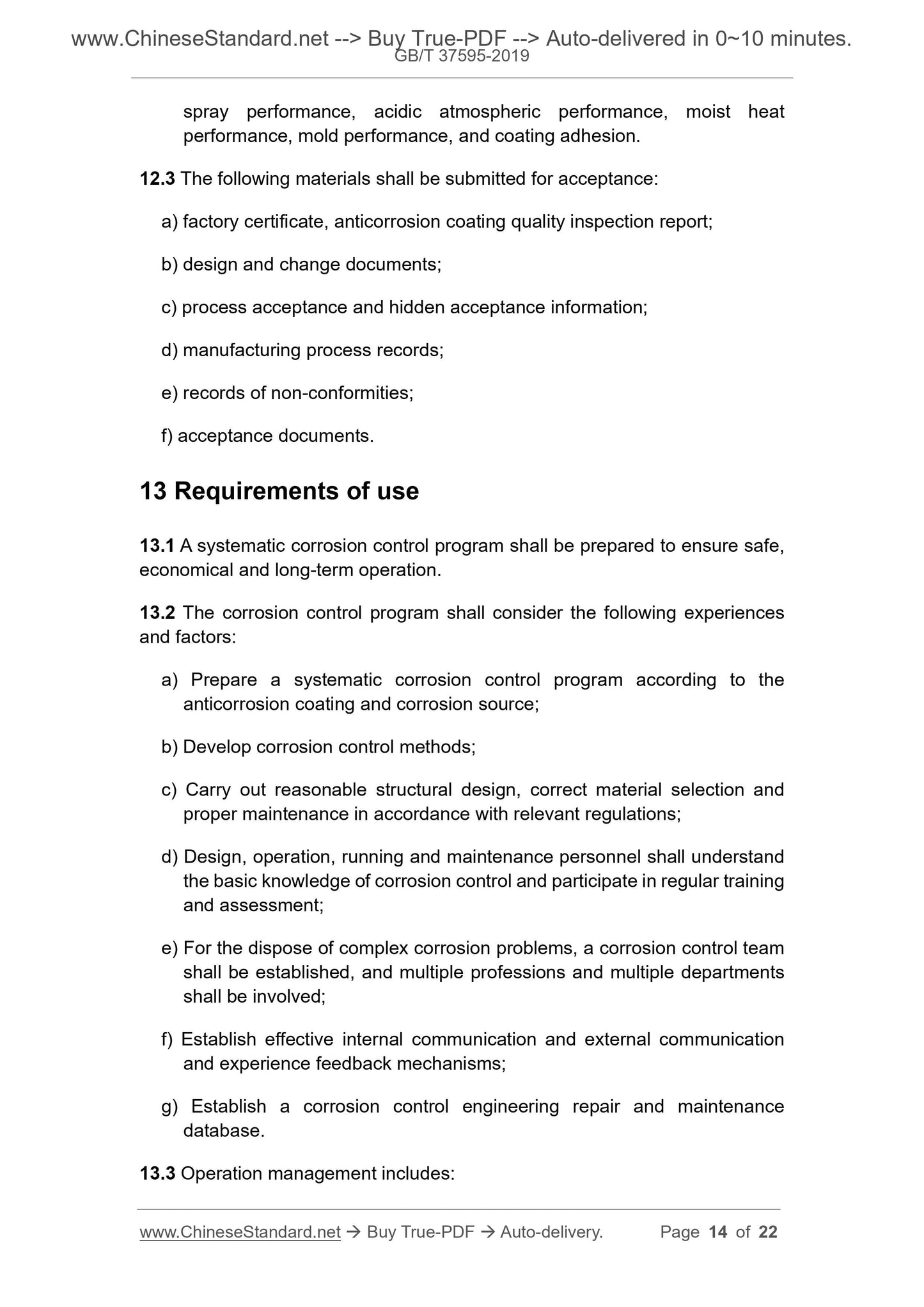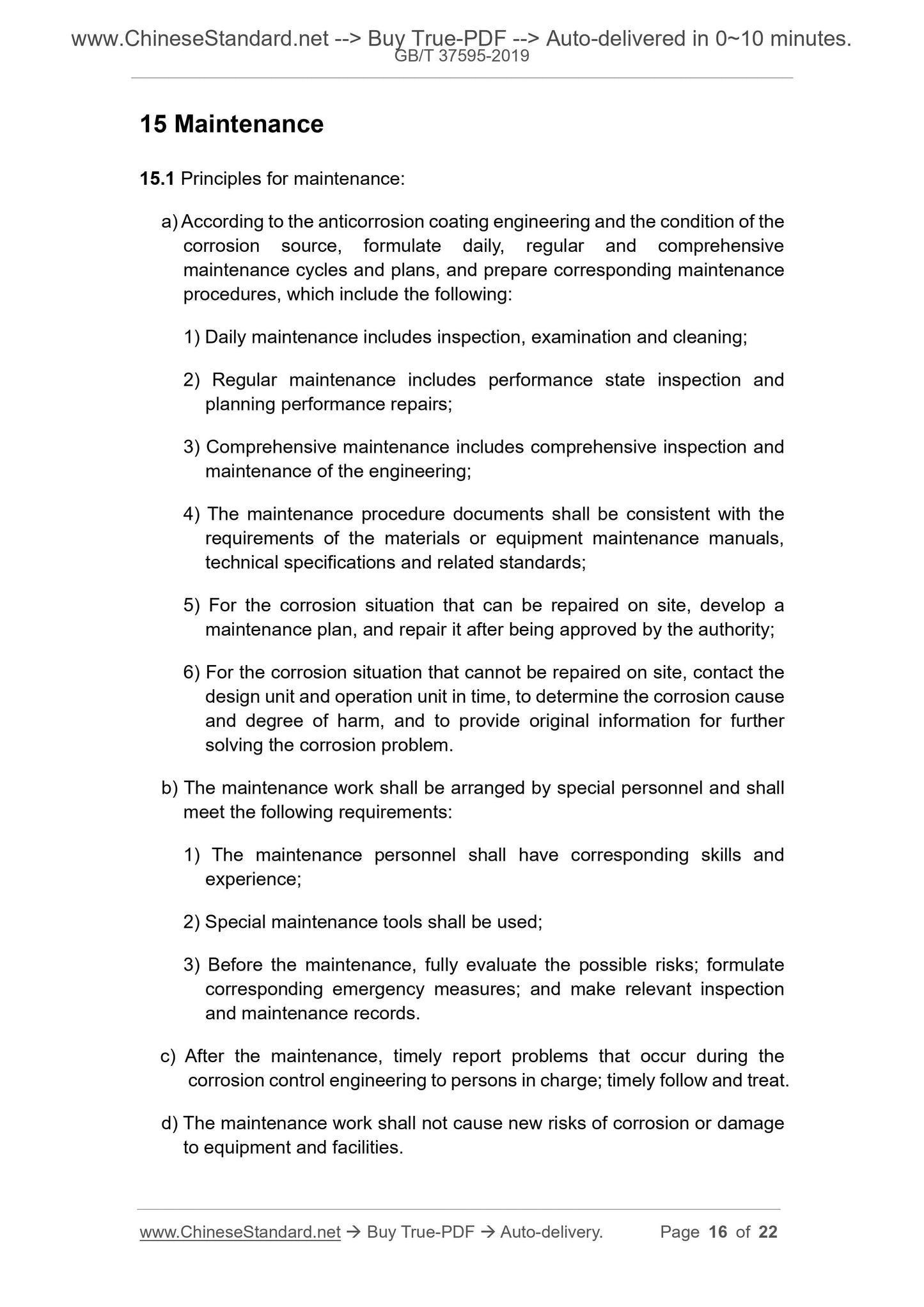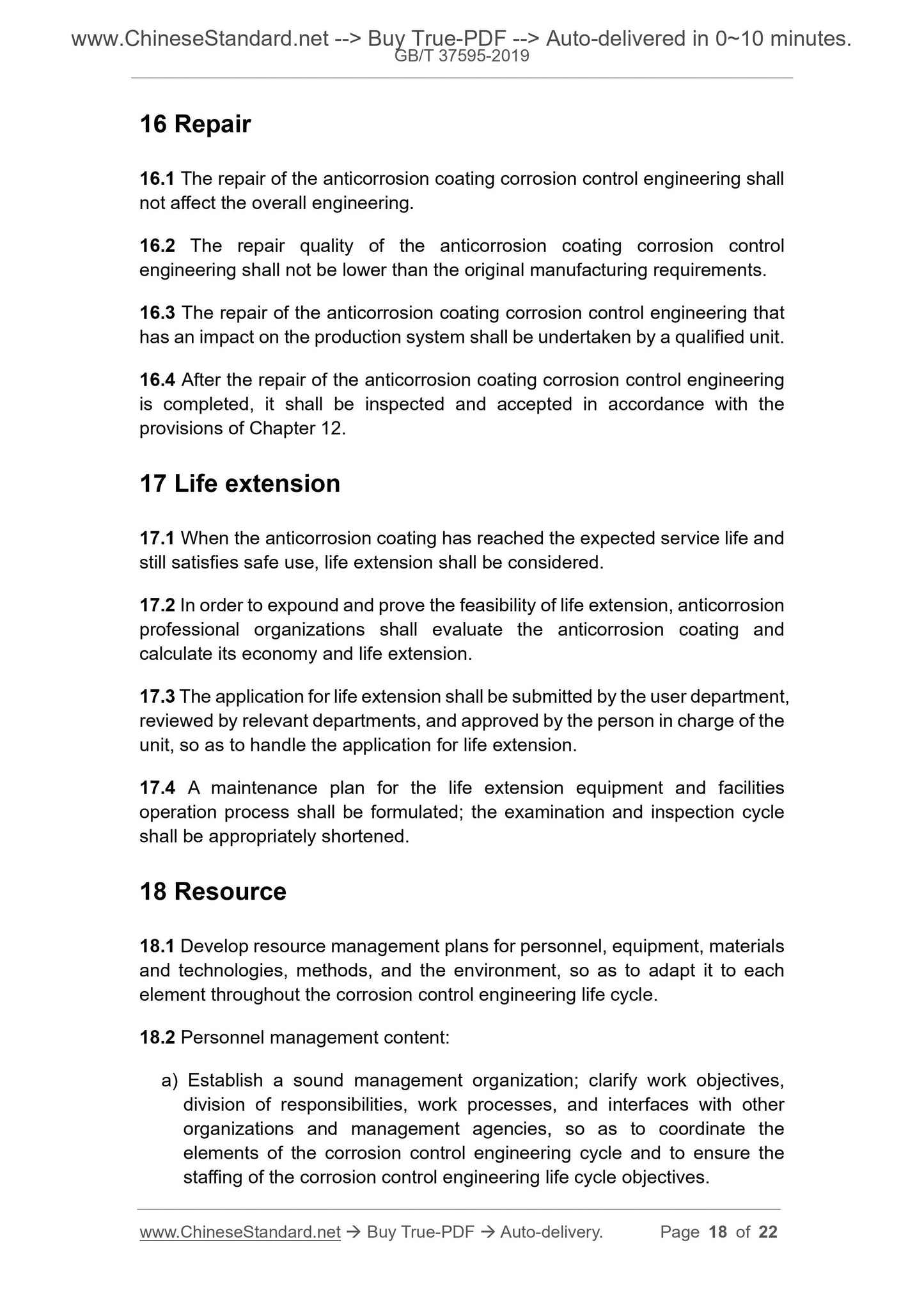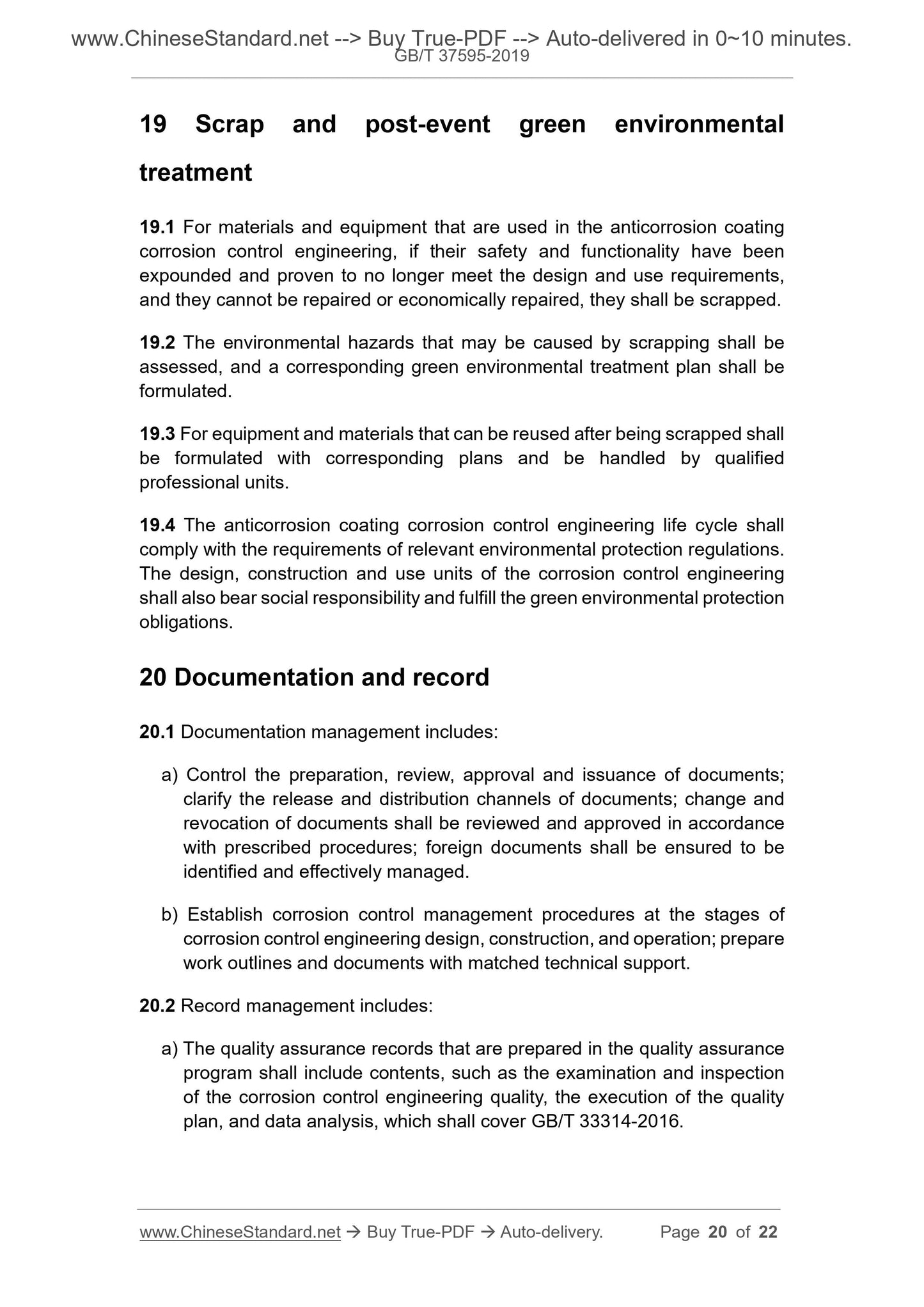1
/
of
10
PayPal, credit cards. Download editable-PDF and invoice in 1 second!
GB/T 37595-2019 English PDF (GBT37595-2019)
GB/T 37595-2019 English PDF (GBT37595-2019)
Regular price
$160.00 USD
Regular price
Sale price
$160.00 USD
Unit price
/
per
Shipping calculated at checkout.
Couldn't load pickup availability
Delivery: 3 seconds. Download true-PDF + Invoice.
Get QUOTATION in 1-minute: Click GB/T 37595-2019
Historical versions: GB/T 37595-2019
Preview True-PDF (Reload/Scroll if blank)
GB/T 37595-2019: General requirements for anticorrosion coating corrosion control engineering life cycle
GB/T 37595-2019
NATIONAL STANDARD OF THE
PEOPLE’S REPUBLIC OF CHINA
ICS 03.100.99
A 01
General requirements for anticorrosion coating
corrosion control engineering life cycle
ISSUED ON: JUNE 04, 2019
IMPLEMENTED ON: MAY 01, 2020
Issued by: State Administration for Market Regulation;
Standardization Administration of the People’s Republic of
China.
Table of Contents
Foreword ... 3
1 Scope ... 4
2 Normative references ... 4
3 Terms and definitions ... 4
4 General ... 5
5 Objective ... 5
6 Corrosion source ... 6
7 Anticorrosion coating ... 6
8 Technology ... 8
9 Development ... 9
10 Design ... 10
11 Corrosion control operation ... 11
12 Acceptance ... 13
13 Requirements of use ... 14
14 Test and inspection ... 15
15 Maintenance ... 16
16 Repair ... 18
17 Life extension ... 18
18 Resource ... 18
19 Scrap and post-event green environmental treatment ... 20
20 Documentation and record ... 20
21 Assessment ... 21
General requirements for anticorrosion coating
corrosion control engineering life cycle
1 Scope
This Standard specifies requirements for objective, corrosion source,
anticorrosion coating, technology, development, design, corrosion control
operation, acceptance, use requirements, test and inspection, maintenance,
repair, life extension, resource, scrap and post-event green environmental
treatment, documentation and record, assessment of each corrosion control
element of anticorrosion coating corrosion control engineering life cycle.
This Standard applies to the management of related activities throughout
various types of anticorrosion coating corrosion control engineering life cycle.
2 Normative references
The following documents are indispensable for the application of this document.
For dated references, only the dated version applies to this document. For
undated references, the latest edition (including all amendments) applies to this
document.
GB/T 33314-2016, Corrosion control engineering life cycle - General
requirements
3 Terms and definitions
Terms and definitions determined by GB/T 33314-2016 and the following ones
are applicable to this document. For ease of use, some of the terms and
definitions in GB/T 33314-2016 are repeated below.
3.1 Anticorrosion coating
A coating that protects the base material.
Note: It includes metal coating, organic coating, inorganic coating, etc.
3.2 Anticorrosion coating corrosion control engineering life cycle
The whole process of the anticorrosion coating, such as corrosion source
investigation, scheme design, construction, inspection, acceptance,
assessment, operation, maintenance, repair, and scrap.
communication, implementation and maintenance shall be made during all links
of the life cycle; regular review and technical improvement of its continuous
adaptability shall be made.
5.3 Coordinate and optimize each element in the corrosion control engineering
life cycle, so that the corrosion control engineering life cycle is compatible with
the life cycle of the protected main engineering, or at least the overhaul period
of the protected main engineering.
5.4 The anticorrosion coating corrosion control engineering life cycle must meet
the requirements of relevant environmental protection regulations. When it is
scrapped, it is necessary to assess the possible environmental hazards and
develop a plan to meet the requirements of the green environment.
6 Corrosion source
6.1 The corrosion sources that cause anticorrosion coating corrosion include
internal and external factors. Internal factors shall consider factors such as
material composition, structure, stress, surface condition, component assembly
and connection methods; external factors shall consider the corrosive media
and working conditions that interact with the anticorrosion coating under
different conditions.
6.2 During the corrosion control engineering life cycle, according to the different
influences of corrosion sources on various types of coatings, it shall conduct
investigation and analysis of corrosion sources, and adopt targeted corrosion
control engineering techniques and management measures.
6.3 It shall identify the overall working conditions of the main engineering
corresponding to the corrosion control engineering, including but not limited to
the operating temperature, humidity, medium, rainfall, sunshine, wind direction,
industrial exhaust gas and other working conditions that are related to the main
engineering.
6.4 The conditions of the corrosion control engineering itself shall also be
identified, including but not limited to parameters such as coating thickness,
corrosion-resistance, abrasion-resistance, impact-resistance, protective area,
coating hardness, and the bonding force between the coating and the base
material.
7 Anticorrosion coating
7.1 For the selection of anticorrosion coating, according to the type of material,
the surface state, and the type and rating of the to-be-faced corrosion
10 Design
10.1 General provisions include:
a) For the corrosion problems that may occur during the anticorrosion coating
corrosion control engineering life cycle, corrosion control measures shall
be taken;
b) Develop design control measures, so as to ensure that the technical
requirements and quality standards of the design are incorporated into the
design plan;
c) Develop management procedures to control changes and deviations from
design requirements and quality standards;
d) Develop special process management measures, to optimize the selection
of key materials, equipment and processes, and to periodically review the
applicability.
10.2 Specify the internal and external interfaces between the design unit and
personnel; clarify the preparation, proofreading, review, approval, release,
distribution and revision responsibilities of documents; specify the transmission
and archiving methods of design documents.
10.3 The design content is as follows:
a) It includes structural anticorrosion design, structural material selection,
component anticorrosion design, anticorrosion coating selection,
manufacturing process, anticorrosion coating maintenance/ repair
program, etc.;
b) The designed system, components and materials shall have an adaptable
margin to meet the requirements of the corrosion control engineering life
cycle under normal operating conditions.
10.4 The design shall follow the following procedures:
a) Design input includes corrosion source, corrosion parameters and grades,
design life, operating conditions, structures, materials, regulations,
environmental requirements, standards and technical specifications.
b) Design output, according to the requirements of the design input,
determines the corrosion control method to form a complete design plan
for the corrosion control engineering.
c) The design verification method is as follows:
certificate of quality and inspection data; random inspection and re-
inspection shall be performed when it enters the venue.
b) Document preparation: formulate the corrosion control operation quality
plan; compile and control the special process control points that affect
quality; determine the quality; formulate the engineering schedule control
table.
c) Preparation of corrosion control operation documents: the operation unit
prepares the construction organization design and submits it to the
Get QUOTATION in 1-minute: Click GB/T 37595-2019
Historical versions: GB/T 37595-2019
Preview True-PDF (Reload/Scroll if blank)
GB/T 37595-2019: General requirements for anticorrosion coating corrosion control engineering life cycle
GB/T 37595-2019
NATIONAL STANDARD OF THE
PEOPLE’S REPUBLIC OF CHINA
ICS 03.100.99
A 01
General requirements for anticorrosion coating
corrosion control engineering life cycle
ISSUED ON: JUNE 04, 2019
IMPLEMENTED ON: MAY 01, 2020
Issued by: State Administration for Market Regulation;
Standardization Administration of the People’s Republic of
China.
Table of Contents
Foreword ... 3
1 Scope ... 4
2 Normative references ... 4
3 Terms and definitions ... 4
4 General ... 5
5 Objective ... 5
6 Corrosion source ... 6
7 Anticorrosion coating ... 6
8 Technology ... 8
9 Development ... 9
10 Design ... 10
11 Corrosion control operation ... 11
12 Acceptance ... 13
13 Requirements of use ... 14
14 Test and inspection ... 15
15 Maintenance ... 16
16 Repair ... 18
17 Life extension ... 18
18 Resource ... 18
19 Scrap and post-event green environmental treatment ... 20
20 Documentation and record ... 20
21 Assessment ... 21
General requirements for anticorrosion coating
corrosion control engineering life cycle
1 Scope
This Standard specifies requirements for objective, corrosion source,
anticorrosion coating, technology, development, design, corrosion control
operation, acceptance, use requirements, test and inspection, maintenance,
repair, life extension, resource, scrap and post-event green environmental
treatment, documentation and record, assessment of each corrosion control
element of anticorrosion coating corrosion control engineering life cycle.
This Standard applies to the management of related activities throughout
various types of anticorrosion coating corrosion control engineering life cycle.
2 Normative references
The following documents are indispensable for the application of this document.
For dated references, only the dated version applies to this document. For
undated references, the latest edition (including all amendments) applies to this
document.
GB/T 33314-2016, Corrosion control engineering life cycle - General
requirements
3 Terms and definitions
Terms and definitions determined by GB/T 33314-2016 and the following ones
are applicable to this document. For ease of use, some of the terms and
definitions in GB/T 33314-2016 are repeated below.
3.1 Anticorrosion coating
A coating that protects the base material.
Note: It includes metal coating, organic coating, inorganic coating, etc.
3.2 Anticorrosion coating corrosion control engineering life cycle
The whole process of the anticorrosion coating, such as corrosion source
investigation, scheme design, construction, inspection, acceptance,
assessment, operation, maintenance, repair, and scrap.
communication, implementation and maintenance shall be made during all links
of the life cycle; regular review and technical improvement of its continuous
adaptability shall be made.
5.3 Coordinate and optimize each element in the corrosion control engineering
life cycle, so that the corrosion control engineering life cycle is compatible with
the life cycle of the protected main engineering, or at least the overhaul period
of the protected main engineering.
5.4 The anticorrosion coating corrosion control engineering life cycle must meet
the requirements of relevant environmental protection regulations. When it is
scrapped, it is necessary to assess the possible environmental hazards and
develop a plan to meet the requirements of the green environment.
6 Corrosion source
6.1 The corrosion sources that cause anticorrosion coating corrosion include
internal and external factors. Internal factors shall consider factors such as
material composition, structure, stress, surface condition, component assembly
and connection methods; external factors shall consider the corrosive media
and working conditions that interact with the anticorrosion coating under
different conditions.
6.2 During the corrosion control engineering life cycle, according to the different
influences of corrosion sources on various types of coatings, it shall conduct
investigation and analysis of corrosion sources, and adopt targeted corrosion
control engineering techniques and management measures.
6.3 It shall identify the overall working conditions of the main engineering
corresponding to the corrosion control engineering, including but not limited to
the operating temperature, humidity, medium, rainfall, sunshine, wind direction,
industrial exhaust gas and other working conditions that are related to the main
engineering.
6.4 The conditions of the corrosion control engineering itself shall also be
identified, including but not limited to parameters such as coating thickness,
corrosion-resistance, abrasion-resistance, impact-resistance, protective area,
coating hardness, and the bonding force between the coating and the base
material.
7 Anticorrosion coating
7.1 For the selection of anticorrosion coating, according to the type of material,
the surface state, and the type and rating of the to-be-faced corrosion
10 Design
10.1 General provisions include:
a) For the corrosion problems that may occur during the anticorrosion coating
corrosion control engineering life cycle, corrosion control measures shall
be taken;
b) Develop design control measures, so as to ensure that the technical
requirements and quality standards of the design are incorporated into the
design plan;
c) Develop management procedures to control changes and deviations from
design requirements and quality standards;
d) Develop special process management measures, to optimize the selection
of key materials, equipment and processes, and to periodically review the
applicability.
10.2 Specify the internal and external interfaces between the design unit and
personnel; clarify the preparation, proofreading, review, approval, release,
distribution and revision responsibilities of documents; specify the transmission
and archiving methods of design documents.
10.3 The design content is as follows:
a) It includes structural anticorrosion design, structural material selection,
component anticorrosion design, anticorrosion coating selection,
manufacturing process, anticorrosion coating maintenance/ repair
program, etc.;
b) The designed system, components and materials shall have an adaptable
margin to meet the requirements of the corrosion control engineering life
cycle under normal operating conditions.
10.4 The design shall follow the following procedures:
a) Design input includes corrosion source, corrosion parameters and grades,
design life, operating conditions, structures, materials, regulations,
environmental requirements, standards and technical specifications.
b) Design output, according to the requirements of the design input,
determines the corrosion control method to form a complete design plan
for the corrosion control engineering.
c) The design verification method is as follows:
certificate of quality and inspection data; random inspection and re-
inspection shall be performed when it enters the venue.
b) Document preparation: formulate the corrosion control operation quality
plan; compile and control the special process control points that affect
quality; determine the quality; formulate the engineering schedule control
table.
c) Preparation of corrosion control operation documents: the operation unit
prepares the construction organization design and submits it to the
Share
